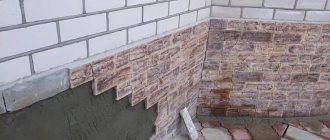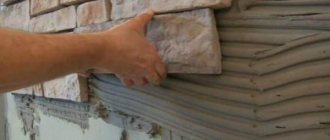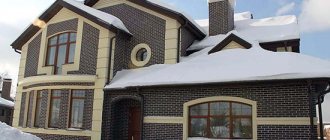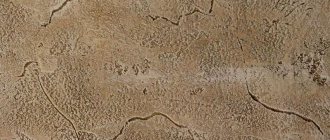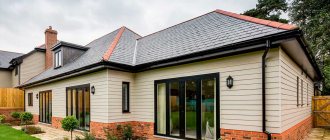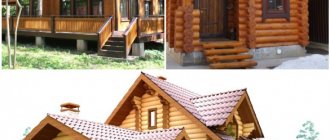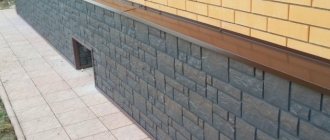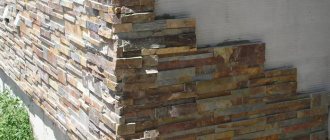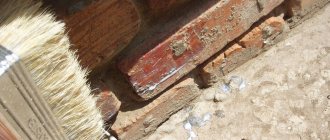Cladding is necessary for the plinth due to direct contact with the ground. Waterproofing this part of the building protects it and the walls of the house from moisture, dampness and rotting. But it alone may not be enough to constantly resist bad weather (rain, snow and the dampness that accompanies them). High-strength and moisture-resistant facing tiles used for the basement of a house can serve as good additional protection.
It is stronger and slightly thicker than facade tiles. In frame-type houses, in which the base protrudes beyond the boundaries of the walls, it is mandatory to make a drip to protect the base of the wall and the base from the accumulation of water. For a private homeowner who has construction skills, it will not be difficult to finish the base with tiles and make a base flashing (if necessary) on their own.
Under no circumstances should you use tiles (except polymer ones) for cladding the wooden base of a house.
Cladding is needed, at a minimum, to insulate the house
Requirements for tiles for cladding
Based on the expected loads on the base of the house, a number of requirements are imposed on the selected tile:
- Sufficient strength of the material. The structure of the tile must withstand significant mechanical and climatic loads.
- The resistance of the material to temperature changes is assessed, which is very important in regions with harsh climatic conditions.
- Greater thickness of the tile module than the thickness of the tiles for wall decoration.
- Advantageous design, which most models have (for example, clinker tiles for the plinth).
- Be sure to check the reliability of the manufacturing company, which has certified tile manufacturing technology.
Technical characteristics such as the degree of adhesion to the underlying base and the need to prepare the underlying surface for subsequent tiling are also important. The best tiles for the basement of a house fully meet all the requirements.
Optimal selection criteria
The choice of tiles for cladding the basement, especially of a residential building, is best left to professionals. Construction specialists will prepare a project according to which all criteria will be taken into account:
- Soil characteristics and proximity to groundwater.
- The angle of inclination of the land plot. This parameter allows you to roughly estimate the risk of rainwater flowing under the foundation of a building.
- The height of the base and its length.
- Estimated mechanical load on the base of the house.
Specialists will draw up a diagram of the land plot, which will show the location of communication lines, in particular, sewer and water pipes.
Photo
To imagine how the basement of a house could be designed, we suggest looking at a selection of photos.
Main types of tiles for cladding
Facade tiles, which are used for finishing the basement and not only (swimming pools, basements, underground garages), are produced using special technologies. The techniques used allow manufacturing companies to produce the following types of especially durable tiles on the construction goods market:
- Natural stone tiles.
- Porcelain tiles for the plinth.
- Clinker models with imitation of various surfaces (for example, stone tiles for the basement of a house).
- Material with a polymer structure.
- Tiles created on the basis of natural resins.
Today, ceramic facing tiles for plinths are also popular among craftsmen, however, this model is distinguished by a significantly larger module thickness.
Each of the known types of finishing tiles has a number of features, technical characteristics, and requirements for the underlying surface.
Grouting joints
Each type of tile requires its own grout, compatible with it and the material for its cladding. The larger the mutula, the smaller the number of seams, which means that less grouting and work is required to implement it.
Don't forget to choose the grout color
The entire surface is treated with a construction roller, taking into account cracks and depressions - even small ones. After processing the seams, it is undesirable to expose them to water and direct sunlight.
The color of the grout and its properties are selected in advance, based on the color and properties of the mutula and the design, if used.
Natural stone tiles
This type of material is the most expensive option, which requires significant financial investments in the tile itself, in preparing the base, and installing a decorative coating.
Popular models include tiles made of marble, granite, slate, and limestone. Such compositions have sufficient strength, perfectly protect the base from moisture, and easily tolerate temperature changes.
Note!
Epoxy grout for tiles: pros and cons, scope, varieties, how to work with it (instructions + photos)
Do-it-yourself tile shower tray step by step: instructions, dimensions, design, installation of communications, types of structures, photos
White tiles in the bathroom: 170 photos of the best ideas and new tile designs. Layout schemes and beautiful combinations
Artificial stone tiles
This coating often acts as an alternative option for cladding the base. Its strength is in no way inferior to the previous type of coating, especially if the production technology uses a combination of natural stone and artificial stone chips.
Thanks to modern technologies, tiles with a smooth or textured surface are being released onto the building materials market, which will allow you to experiment with the design of the base. The admixture of coloring pigments and natural chips gives the surface of the tile modules a unique design and pattern.
Clinker tile types
The most well-known material for finishing the basement of a building today is clinker tiles. It has a very durable structure and resistance to a number of damaging factors.
On the finishing materials market you can find stone-like clinker tiles for decorating the base. The material can be used without replacement for decades, and its resistance to moisture, hail, and chemical compounds is the highest among all known coatings.
Recommendations for performing work
It is difficult for a person who is laying tiles for the first time to take into account all the nuances. Finishing specialists give their recommendations:
- To ensure that the cladding is even along the entire perimeter of the house, the first row is laid on a metal profile. The guide is set horizontally; it will serve as a beacon for leveling the tiles.
- When choosing an adhesive solution, carefully read the instructions. The composition must be intended for exterior use and plinth tiles. The wrong solution may not hold up a heavy finish.
- The reliability of fastening the finish using the wet method is increased by reinforcement with metal mesh.
The final stage of finishing the base is the installation of an ebb lining above the finishing material. Installing special elements will protect the decorative cladding from erosion by precipitation.
Polymer based tiles
Polymer facade tiles for exterior finishing of basements are very popular. The production technology uses the optimal ratio of sand, synthetic polymers, coloring pigments and stabilizers.
Note!
Italian tiles for floors and walls: photos of beautiful tile designs in the bathroom and kitchen. Choosing tile color, style and size
Marble tiles for the bathroom: TOP-200 photos of original design, ideas for mixing and matching
Do-it-yourself tile shower step by step: instructions, algorithm of actions, dimensions, layout diagrams, photo of a shower with and without a tray
It is the presence of the last ingredient that gives the surface of the tiled module special strength and resistance to moisture and other climatic factors.
A distinctive feature of this coating is the possibility of attaching blocks to waterproofing using ordinary screws or self-tapping screws. Facing the facade with polymer tiles allows you to hide all existing irregularities on the surface of the base.
Why do you need and what are plinth tiles for the facade?
A finishing material that can withstand these loads must have high strength and water resistance, which is best demonstrated by plinth tiles. Unlike other types of cladding, plinth tiles provide the ability to install elements independently without mechanically connecting them to each other.
This feature makes it possible, if necessary, to easily replace one or more elements without dismantling the entire wall cladding to the point of damage . A characteristic feature of plinth tiles is also the ability to be installed on top of insulation, which allows you to create a ventilated façade or a dense surface without air access.
IMPORTANT!
The name “basement” does not limit the use of the material to only the lower part of the house. The tiles are successfully used as a full-fledged facade covering, as a finishing material for pools, columns, etc.
Tiles based on natural resins
A very interesting version of facing tiles can be found in modern construction supply stores. The use of various resins in production allows you to create a unique material that bends at any angle.
If necessary, modular blocks can be cut with construction scissors. After laying, the tiles will provide reliable protection against natural moisture, but only if the finishing work is carried out optimally.
For the glue to completely and successfully harden, it will take about three days and absolutely dry weather.
Note!
Mosaic from broken tiles: step-by-step instructions on how to lay it out with your own hands (140 photo ideas)
Mosaic for the bathroom: TOP-150 photos of new designs, as well as modern ideas for combining mosaic tiles
Do-it-yourself water heated floor under tiles step by step: installation instructions with photos and descriptions, installation and connection
Preliminary surface finishing
One of the key points of construction and finishing work is the preparation of the underlying surface. Laying the plinth with tiles begins immediately after the preparatory work:
- The old coating from the base must be removed. Pay attention to even the smallest pieces that can cause poor adhesion of the new material.
- The surface of the base must be leveled, especially if there are unevenness and gross defects.
- After thorough cleaning of dust, they begin laying hydro- and thermal insulation. If necessary, install a reinforcing mesh.
Applying several layers of primer to the surface will increase the resistance of the facing tiles to low temperatures.
Calculation of the required quantity
The number of tiles directly depends on the surface area of the plinth . If it is uneven, it is recommended to count it in blocks and then fold it. Divide the resulting area by the area of one tile part, subtract the size of the planned grout joints and add 5% in case of damage or rework.
Usually, when purchasing, the seller himself measures the amount of material needed, plus there are sites with automatic calculation of these parameters.
The consumption of glue and grout is written on the packaging, the amount is determined by square meters of area for installation.
Do-it-yourself tiling of the base with tiles
In practice, two main methods of tiling the base are used: dry and wet (classic finishing) methods. Step-by-step finishing of the basement of a house with tiles using the dry method:
- Attach a lathing made from a profile to the prepared surface.
- They begin to attach the facing tiles on top of the sheathing using self-tapping screws.
The technique is quite simple, but has its drawbacks. It is impossible to achieve complete tightness in this way, which means that moisture will get between adjacent tile modules.
The second method of finishing the plinth with facade tiles is recognized as classic, and is more often used in practice:
- After installing the reinforcing mesh (this stage of work is optional), an adhesive solution is applied to the surface of the base. Reinforcing mesh is often used when finishing the base with clinker tiles.
- Tile laying begins from the upper far corner, constantly monitoring the quality of the arrangement of tile modules using a building level.
- Be sure to maintain the time required for the adhesive to dry.
After the solution has completely hardened, they begin to grout the joints with a moisture-resistant compound. For ease of use, spatulas of various sizes are used. This approach makes it possible to make the tile masonry completely sealed and resistant to moisture.
Laying features
To lay tiles using a dry method (if the material allows it), preliminary installation of a sheathing or subsystem is required. It is a system of strips located at such a distance from each other to provide the possibility of attaching tiles .
The material used for the subsystem is wooden blocks, guides for installing drywall, or, less commonly, specialized subsystems produced for certain types of cladding. The dry method is successfully combined with external wall insulation, as it does not interfere with the proper functioning of the insulation and promotes the removal of steam from wall materials .
At the same time, before installing the cladding, it is necessary to install a sealed, one-way waterproof membrane that prevents the insulation from getting wet, but facilitates the removal of steam from it.
Wet installation has much in common with conventional tile installation. The presence of corner elements makes it easier to design corners, window or door openings, and protruding architectural elements.
The tiles are installed using an appropriate adhesive designed for outdoor use and able to withstand temperature changes and moisture . Installation is carried out according to the usual method - a horizontal support bar is installed from below, on which the bottom row of material rests.
To ensure equal distances between tiles, plastic crosses of a certain size are used.
Seamless installation is not recommended, since water gets into the cracks between the tiles, which, when frozen, can destroy or tear the tiles from the base . The joints are grouted with the same glue on which the cladding is installed or with a special compound that has a contrasting color, creating an additional decorative effect.
IMPORTANT!
Installation of tiles is carried out in suitable conditions - at above-zero temperatures, dry weather without strong scorching rays of the sun.
